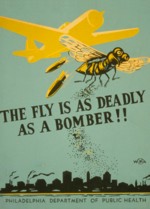An interesting post by A.E.Brain, an Aussie blogger, on contrasts between style and substance when it comes to governments:
The most reviled form of Government in recent times has been National Socialism. With Good Reason. The two most famous – or infamous – National Socialist parties have been the NSDAP (Nationalsozialistische Deutsche Arbeiterpartei – National Socialist German Workers’ Party) AKA “Nazi” party, and the ANSP (Arab National Socialist Party) AKA “Ba’ath” Party.
But… a bad form of Government executed by Good People is better than a good form of Government executed by Bad People. therefore present for you a contrast in styles, of two “National Socialist” movements, though one of them didn’t call itself that. Judge for yourself.


National Socialism often conveys Public Service messages in
militaristic terms, but not always
I do agree with A.E.Brain that there are similarities in the ways that states, regardless of their ideology, usurp a prominent place in the social interactions. It is the desire for total politicisation of the civil society that makes Communism and Nazism such intimate ideological bed-fellows. Practically too, there is not much difference between a concentration camp and a gulag, except the fact that many more millions died in gulags. As a commenter in this thread put it:
The commie shoots ’em in the head,
The facist, in the skull.
Their ideological differences
For victims, rather null.
The US posters skillfully juxtaposed with their Nazi ‘counterparts’ use identical imagery and the similarities in style are meant to be sinister. But it should not really come as a surprise, since propaganda toolbox was not as ‘diverse’ in those days and both Nazis and Communists would have used and perfected the ‘marketing’ techniques of the day. The more subtle reminder is the pervasive hijacking by the state of the ‘positive’ collective sentiments that are transformed into a collectivist norm imposed by force.
A.E.Brain concludes:
What’s important is the matters of Substance, like the very real differences that existed between the Franklin&Eleanor team and Adolf.
Absolutely. There is only one small fallacy in his argument. Propaganda does not equal style, at least not in any meaningful sense. So although National Recovery Administration (NRA) was no doubt bureaucratic and authoritarian in its nature, I cannot see the implementation of its policies being even vaguely reminescent of the ways of Nazi or Communist institutions. In the end, precisely because of its authoritarian substance (and style), the NRA did not last long enough to even fully implement its policies.
What the posters demonstrate is that States have instinctive tendencies to take over the society whether by force or ideology or a threat of external/internal enemy. Toxic ideologies will turn the state into an instrument of terror. Credible or fabricated external/internal threats will enable the state to expand its powers and effective use of force will make the state a frightening tool in the hands of those who wield it.
The difference is not just what those who are in power believe but also what kind of society they face. Both Communism and Nazism have taken over the societies where the rights of individual were not paramount. It is when individual is no longer valued as the corner-stone of the society and his freedoms protected from collectivist impositions, the state is unrestrained in its natural course.




The other thing the posters demonstrate is how visual style evolves:
(1) They both look very similar to us because things are done so differently now, but at the time they would have been more obviously different.
(2) Current affairs influence the expression of a message as well as the visual techniques available. Comparisons with a bomber wouldn’t have come as easily to the Philadelphia Department of Health during an extended period of peace.